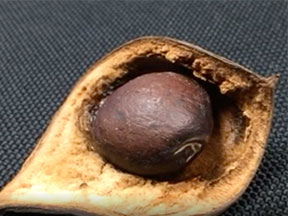Case Western Reserve biologist explores wider uses for Namibian “orphan legume;” Marama bean grows in drought conditions and shows resistance to pests
Biology professor and researcher Christopher Cullis said he pondered two big questions when he first caught sight of the wild marama bean plant, its definitive patches of green leaves standing out in contrast from among an otherwise parched and brown Namibian landscape.
“Why isn’t this plant affected by the lack of water like everything else—and why isn’t it being eaten by any wildlife?” Cullis said, turning one of the walnut-sized beans over in his fingers and recalling his first trip to the coastal southwest African country about a decade ago. “The answers to those questions make this a very interesting and important legume.”
In fact, Cullis, the Francis Hobart Herrick Professor of Biology at Case Western Reserve University, and partners at universities from three different African countries assert that the hardy-but-humble Tylosema esculentum could someday rise up as a new alternative crop in the often-arid climates of developing countries.
They believe that, once cultivated, the marama bean could supplement food sources in Namibia and nearby countries and someday provide additional income for farmers through the sale of its oils and oversized tuber root, possibly as a starch alternative for baked goods.
Not only that, but if its drought- and pest-resistant properties can be transferred to other plant species, the marama bean could have an even wider impact, Cullis said.
“Other legumes shut down under the stress of drought and then can’t be rejuvenated, even when watered—but the marama bean never shuts down under the same drought condition,” he said. “This helps inform us on how to make other legumes more drought-resistant, and legumes are an important food source for much of the climate-challenged world already.”

Cullis has collaborated on marama research with scientists from Namibia University of Science and Technology, the Mulungushi University School of Agriculture and Natural Resources in Zambia and the Forestry and Agricultural Biotechnology Institute at the University of Pretoria, South Africa. Their most recent work was published in March in the journal Food and Energy Security.
His role in the research was also featured on a recent episode of Exploradio, a 90-second podcast collaboration between WKSU-FM 89.7 in Kent and physics Professor Glenn Starkman’s Institute for the Science of Origins.
The remarkable marama

The bean, endemic mostly to the Kalahari Desert region, is known to scientists as one of among numerous “orphan legumes” on the African continent, a description that references the dearth of genomic—or plant family—information known about it. Researchers like Cullis and his team are changing that as they dig deeper into understanding its molecular structure and learn more about how it thrives in water-scarce regions.
“Few others are studying this, so we have now become the primary publishers on marama and have the largest database in the world,” said Cullis, who returned in early April from his most recent trip to Namibia, this time with a handful of biology students to help with the research. “We have now sequenced the genome on a good number of individual plants, and we are getting closer to fully understanding the marama.”
The marama plant, thanks in part to that massive tuber (weighing up to 500 pounds) retains moisture better than other plants, possibly by recruiting fungi to help with the work. And it is the seeds of the bean plant which seem to function as a pest deterrent.
It has likely been a minor food source for the indigenous population for 1,000 years, however. They pick the bean from the wild patches, roast them (canceling out the toxicity that make them distasteful to other animals) and then eat them in a fashion similar to a peanut—“although it tastes a lot more like a cashew,” Cullis said.
There were failed attempts to cultivate marama beans in the United States (Texas) and Australia several decades ago, but Cullis said new research and understanding how to transplant the bean might soon allow it to be farmed. Then it could serve as a subsistence, or “rescue crop,” among locals—a possible buffer against food insecurity when other crops fail in an increasing arid climate.
He said researchers associated with the pharmaceutical and cosmetic industries have also shown interest in the seeds because they are abundant and rich in protein and oils.
For more information, contact Mike Scott at mike.scott@case.edu.


